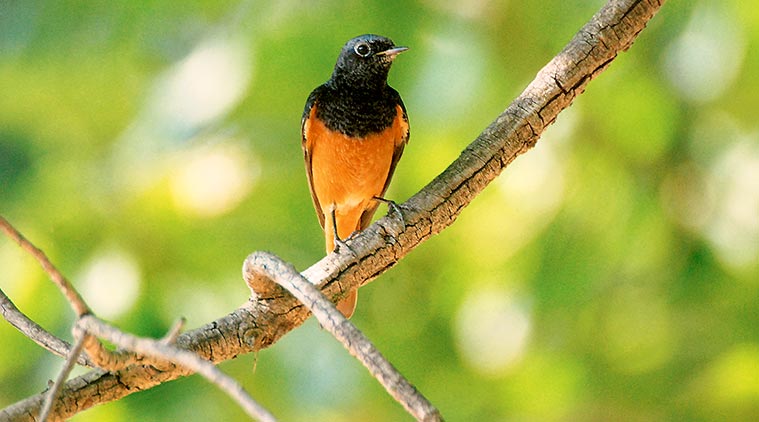 What made matters worse was that we were at that time temporarily “putting up” at a relative’s house in the ostensibly posh Malcha Marg.
What made matters worse was that we were at that time temporarily “putting up” at a relative’s house in the ostensibly posh Malcha Marg.
Ask anyone who’s lived elsewhere in the country — what their first impression of Delhi was when they came to live here and they’ll give you a boiler-plate reply, without batting an eyelid: “Massive culture shock!” And follow it up with bewilderment: why were ordinary people here always scowling and hostile, appraising you from head to toe and belligerently asking you where you “put up” and how much money you made?
And it was not only people. Forty years ago, as I was just getting interested in birds, we shifted here permanently from Bombay. To my horror, I found the birds here, too, were pretty much as in-your-face as everyone else: the jungle babblers behaved like the cops (though the babblers have a secret soft side, which I think cops should observe and inculcate into their training manuals), the parakeets were raucous and querulous, the kites rude and greedy and the mynahs strutted around as though they had just won seats in the Parliament by record margins.
What made matters worse was that we were at that time temporarily “putting up” at a relative’s house in the ostensibly posh Malcha Marg. The tiny garden there was shrouded by a dark brooding tree. Then, one morning, I glanced out of the window and saw it for the first time. A neat-looking bird, perhaps a little larger than a sparrow, sporting an ash-grey crown, black face and lovely ginger-orange breast and underparts. It saw me, bowed politely and shivered its tail before flying down to pick up a tidbit and, perching back on the wall again, bowed and shivered its tail again. The message came through clearly: “Don’t worry, everyone here is not rude and obnoxious! There are still some gentlemen present!”
The bird was the black redstart, a summer breeder in the Himalayas and a winter visitor to Delhi — and most of the rest of India. It has about a dozen cousins, mainly mountain dwellers, but this charcoal, grey and auburn fellow regularly arrived in Delhi by around September or October every year and would stay on till the end of April. His wife was clad in woody-browns with a rufous tail and was as demure and dark-eyed as her husband. They were a punctilious clan — one gentleman would present himself on the garden gate nearly on the same date in the middle of September for years together, maintaining a kind of punctuality that was unheard of here. He would stay through the winter, dropping down into the garden for his tidbits and suddenly one morning in April, be gone. He had a quiet trr-trrr call — and I believe sings quite well in the breeding season.
Soon, I had begun birding regularly on the Northern Ridge. The scrubby, boulder-strewn wooded landscape here seemed to be a favourite with these birds. I’d earmarked a “birding trail” along which several redstarts had marked out their territories. You passed from one bird’s ilaka (zone) to the next ones, knowing exactly where their borders lay. And while the birds were polite and well-mannered and never shouted, they didn’t tolerate incursions and would dive at intruders driving them away in seconds. Gentlemen and ladies kept apart at this time of the year, too. Typically you’d find them perched on a boulder or a low branch and always their calls were a dead giveaway. There was always something soothing about sighting these fellows; they calmed you down. Occasionally, they would drop down near your feet to pick up a juicy spider-tidbit that you’d missed, fly back up and bow, no doubt politely thanking you for letting them have it. Redstarts live on a diet of insects, spiders and other creepy-crawlies, so, that really wasn’t a problem. These winters I don’t see them as frequently as I used to in the garden. Even on the Ridge, they’re harder to winkle out.
I’ve met some of the redstart’s cousins in the mountains, too. Perhaps, the most memorable experience was of stepping into a clearing in Corbett National Park and being brought to a halt by a long sweet whistle-song. There, on a rock, abutting a stream, was a white-capped redstart — he, too, is coal-black and gingery auburn, but his crown is pure white: he could well have been named the snow-capped redstart! His cousin is the white-winged redstart. Another relative is the plumbeous water redstart, clad in slatey blues and not nearly as classy. Redstarts nest in the Himalayas (Kashmir), in rock crevices and holes. Four to six white or pale blue-green eggs are laid between May and August.
For anyone new to Delhi, look out for these genteel birds, in wooded parks and gardens. Just watch awhile and you’ll breathe easier, your pulse and blood pressure will fall and you’ll forget the scowls and frowns of the people who just pushed past you.